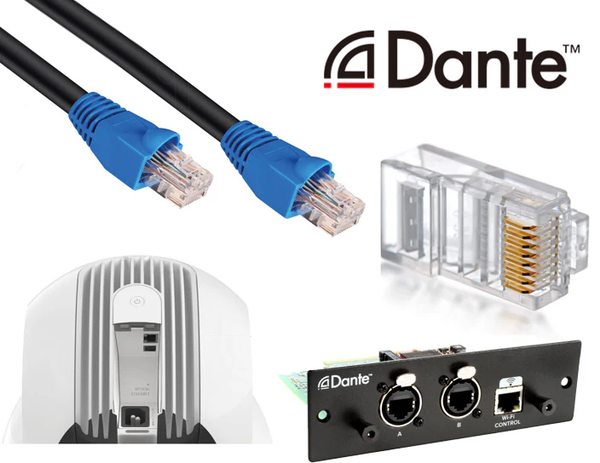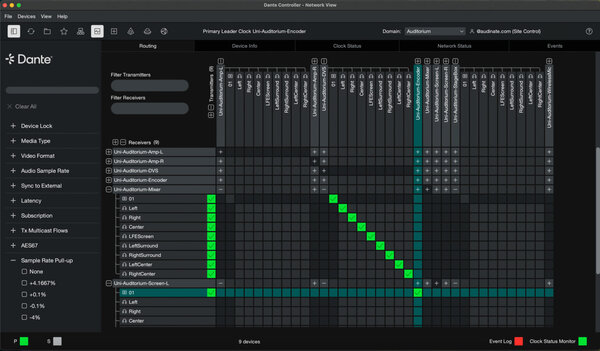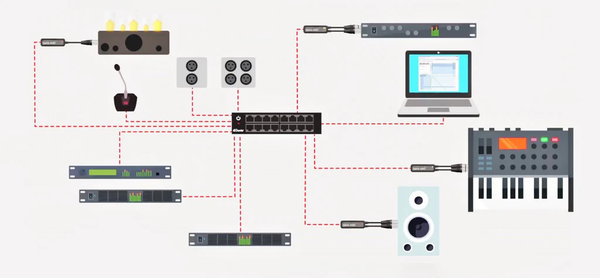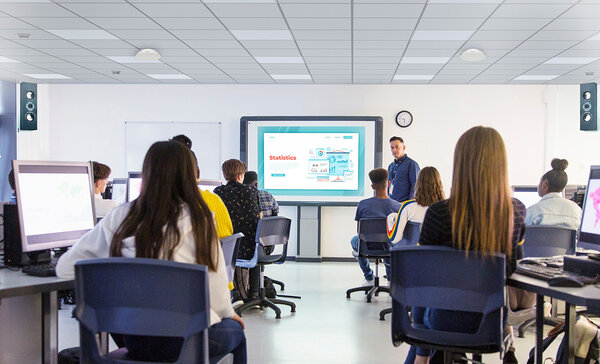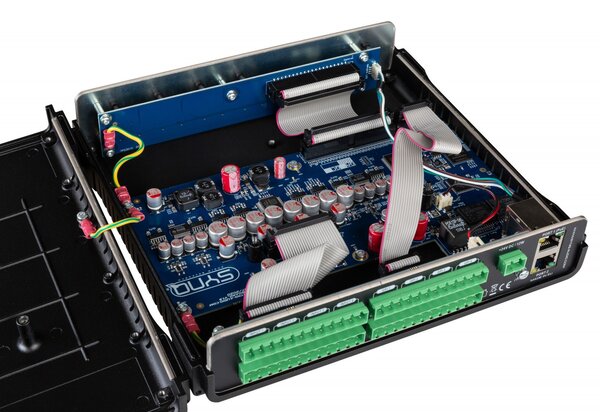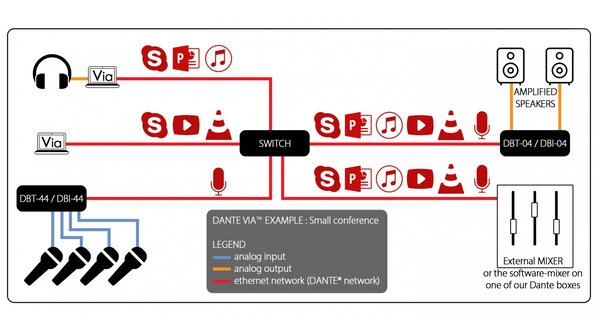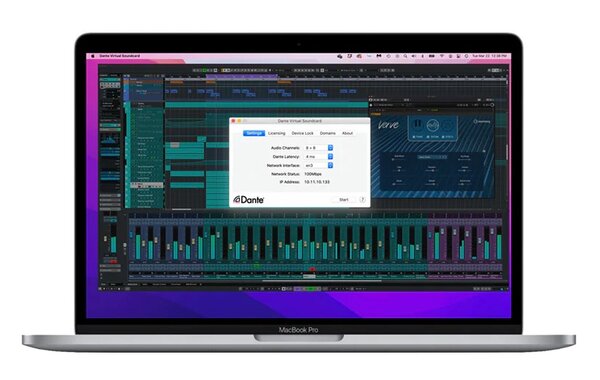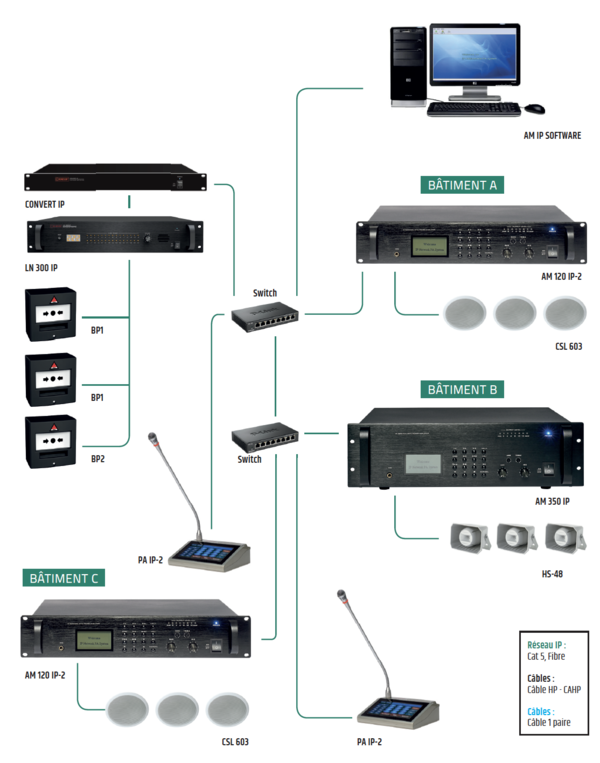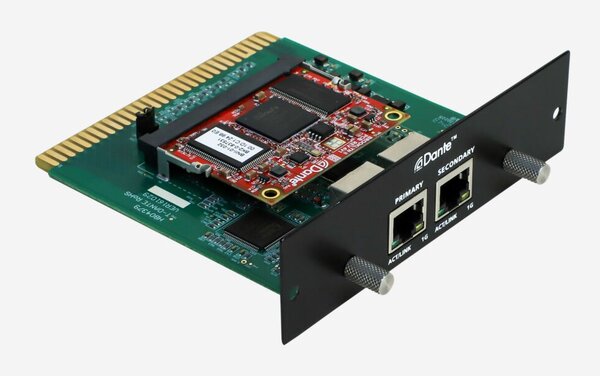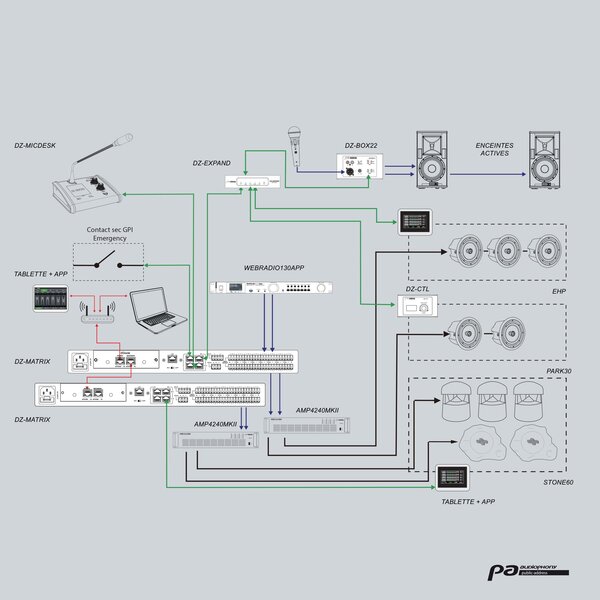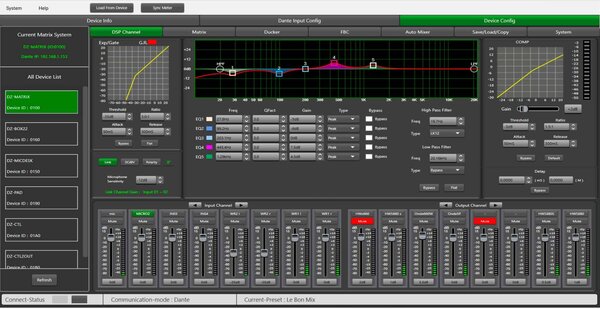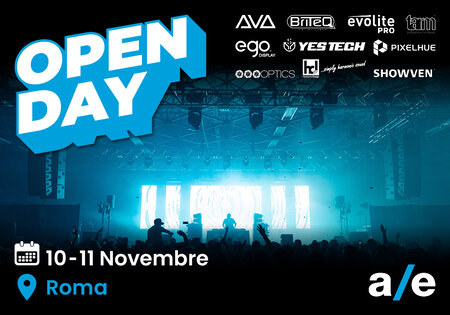Audio over IP has, for several years now, been an essential standard for professional installations thanks to its ability to streamline signal distribution and drastically reduce cabling. Dante is the most widespread technology in this field though not the only one as it enables high-quality multichannel transmission over Ethernet networks. In fixed installations it allows centralized, scalable management of mixers, DSPs, power amplifiers and loudspeakers, making the entire system more flexible and modular.
Audio Effetti offers a complete range of Dante-ready products designed to integrate easily into any IP infrastructure, which we will overview in this article.
As is well known, Dante (Digital Audio Network Through Ethernet) is a protocol developed by Audinate that enables the transmission of digital audio signals over standard Ethernet networks. Unlike traditional analog systems, Dante makes it possible to send dozens or hundreds of audio channels with extremely low latency and seamless synchronization, using simple and cost-effective network cables and switches.
In the world of professional installations, Dante is a turning point: it centralizes control, simplifies cabling, reduces costs, and increases system scalability. It is particularly valued in environments such as theatres, conference rooms, museums, broadcast and corporate facilities, where flexibility and reliability are essential.
Another key advantage is the plug-and-play compatibility between Dante-ready devices: sources, matrices, amplifiers, interfaces and loudspeakers can be connected and automatically recognized on the network; this makes integration and maintenance much faster than with traditional systems.
Within a Dante ecosystem, the (free) Dante Controller software serves as the operations center for control and supervision, allowing you to manage and configure all devices on the network. It is compatible with Windows and macOS and enables audio routing, device status monitoring and firmware updates. Thanks to its intuitive interface, it simplifies the management of even complex systems, making the IP audio infrastructure more flexible and reliable.
Building an Audio over IP system: the sources
Audio sources equipped with a Dante interface such as media players, computers with Dante Virtual Soundcard, or analog sources converted to Dante connect directly to the Ethernet network via CAT5e/CAT6e cable. Each device is connected to one (or more) compatible network switches, which act as the central hub for signal distribution. From there, the audio stream can be routed to various devices using Dante Controller for routing management.
As an example, consider a medium-sized conference room application where you typically need to manage:
- Two or more table microphones, or a ceiling-mounted beamforming microphone
- An audio source (e.g., a media player)
- A PC
- A mobile Bluetooth access point
- Sound reinforcement in the room and in the adjacent corridor
An example of a beamforming microphone is the Sony MAS-A100, one of the most sophisticated models available on the market. It is a ceiling microphone, ready for immediate use, allowing the presenter to speak hands-free and focus on the presentation without worrying about movement. Sony’s advanced digital signal processing and proprietary algorithms extract speech while eliminating unwanted feedback. With Dante and PoE support, the MAS-A100 connects to third-party systems via a single cable.
For audio sources with analog outputs, it is sufficient to use a Dante interface to convert the signal to Audio over IP and place it on the network.
From this standpoint, Audio Effetti offers several interesting solutions. One example is the Synq audio bridges. These devices enable seamless transition from the traditional world of analog and digital signals to Dante over IP and back, maintaining ultra-low latency and ensuring very high audio quality. They therefore act as a “bridge” between both technologies.
Two models are specifically intended for installations:
- DBI-44: performs dual conversion: 4 balanced analog inputs (MIC/line) to Dante network audio, and Dante network audio to 4 balanced analog outputs. It uses IN/OUT Euroblock connectors, which are particularly suitable for fixed installations.
- DBI-04: converts Dante network audio to 4 balanced analog outputs. Useful for taking the signal from the network and converting it to analog for monitoring or other purposes. It also uses Euroblock-type OUT connectors.
Alternatively, if only two channels are needed for example, from the stereo analog output of a media player the Audiophony ConvD2In may be the solution.
This device is a Dante converter from 2 × XLR3-F analog to RJ45. A complementary version is also available, from RJ45 to 2 × XLR3-M analog, to extract analog signal from the Dante network (ConvD2out).
Computers, on the other hand, can transmit and receive multichannel audio via Dante Virtual Soundcard, making them an integral part of the system.
Every device connected to the network is automatically recognized and can be configured without the need for point-to-point cabling. This approach enables flexible and scalable signal distribution, ideal for fixed installations and complex environments.
Note, however, that not all Audio over IP systems are based on Dante. The solution proposed by Rondson, for example, uses TCP/IP for control and signal distribution but relies on proprietary software (AM IP SOFTWARE) and on devices such as RS422–TCP/IP converters, IP amplifiers, IP paging microphones and IP loudspeakers.
It is designed for applications in schools, public PA, PPMS alert messaging, with remote management and configurable zones, but it is not interoperable with Dante-ready devices.
Matrices and amplifiers: the heart of the IP audio infrastructure
In installations, audio signal distribution and amplification are no longer constrained by complex analog systems or rigid configurations. Matrices and amplifiers designed for Dante are now the key elements for building scalable, centralized systems that are fully integrated over the network.
IP audio matrices deliver unprecedented flexibility in signal distribution, allowing customized routing, priority management, and remote system status monitoring. Amplifiers, for their part, integrate seamlessly in this ecosystem.
A first device worth focusing on is the Audiophony PA DZ-MATRIX.
It is a 12 × 12 digital matrix designed for audio management in public spaces and fixed installations. It provides 8 analog inputs and 8 analog outputs, plus 4 remote inputs and 4 remote outputs. The system can be further expanded with 8 digital I/Os and up to 16 units can be networked thanks to the Dante option, available as a separate card (DZ-DANTE).
Once integrated into a Dante network, DZ-MATRIX becomes an IP node capable of receiving and transmitting multichannel audio signals over Ethernet with minimal latency and no synchronization issues. This allows it to be part of a broader ecosystem while simplifying cabling. In a fixed installation, for example, this matrix (with the Dante card) can be used to manage audio distribution in venues such as museums, hotels, conference rooms, shopping centers, or restaurants.
The dedicated software allows configuration of routing, input/output DSP, priorities, auto-mixing, feedback suppression, and preset storage.
The DZ-Control mobile app, compatible with iOS and Android, enables remote control via smartphone or tablet, making management even more flexible.
Turning to power amplifiers, a standout model is the Harmonic Design SpaceAMP1000, a matrix amplifier with 4 × 250 W RMS channels and onboard DSP, engineered to deliver maximum performance in minimal space.
Thanks to 32-bit/96 kHz DSP, it ensures outstanding sound quality and precise signal management, with FIR filters on each output, a 16-band equalizer, input limiters, and loudspeaker presets. Network integration is straightforward due to compatibility with Dante/AES67, an internal Gigabit Ethernet switch, and an integrated wireless access point.
There is also a smaller-power version (hd SpaceAMP500) and a higher-power version (hd SpaceAMP1500).
Dante-ready loudspeakers: the final link in the audio chain
To round out this overview, let’s look at loudspeakers.
A Dante-enabled loudspeaker is, by definition, an active model with a direct IP audio connection via RJ45. It receives the digital signal over Ethernet without the need for analog cabling or external converters.
Segon professional audio, a division of Rondson, has recently introduced a range of installation loudspeakers comprising three models that integrate a Dante module. Power and signal transmission over a single network cable (CAT5 or higher) simplifies installations compared with traditional speakers, also because power is provided via PoE:
-
JS-POE3: active column loudspeaker with four 3" full-range drivers, 70 W Class-D internal amplifier, 92 dB/W/m sensitivity and 150 Hz–18 kHz frequency response. Dispersion 90 × 30 (H × V). Thermal, overload and short-circuit protections.
-
JS-POE6: active installation loudspeaker with 6.5" woofer and 1" tweeter, 60 W Class-D internal amplifier, 94 dB/W/m sensitivity and 50 Hz–20 kHz frequency response. Dispersion 90 × 60 (H × V). Thermal, overload and short-circuit protections.
-
JS-POE2: compact active installation loudspeaker with 4.5" woofer and 1" tweeter, 40 W Class-D internal amplifier, 93 dB/W/m sensitivity and 180 Hz–20 kHz frequency response. Dispersion 60 × 60 (H × V). Thermal, overload and short-circuit protections.
Finally, note that for all Harmonic Design Beam series loudspeakers it is possible to purchase the Dante option (code 400140), as they are prepared for digital streaming of audio packets over a Dante network, without any additional D/A–A/D conversion to the DSP core and integrated amplifiers.
IP audio integration is no longer a future prospect but a well-established reality that is redefining how we design and operate installations. Dante-ready products are therefore strategic tools for building intelligent, adaptable systems that are prepared to evolve. In this context, expertise in selecting and implementing the right solutions becomes the real added value for every installer.
Want to learn more?
Email us at international@audioeffetti.it

 English
English  French
French

